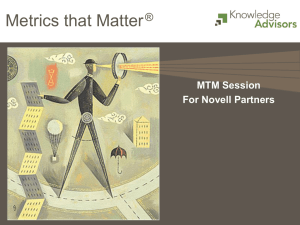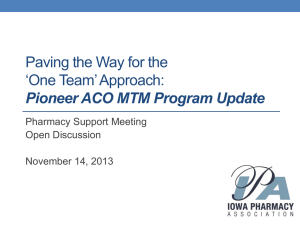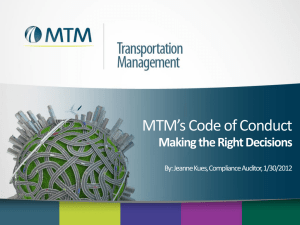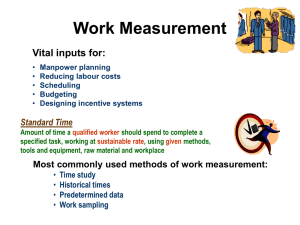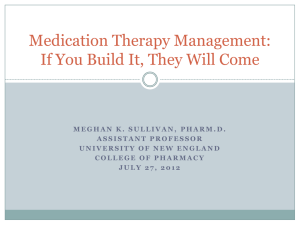MTM
advertisement
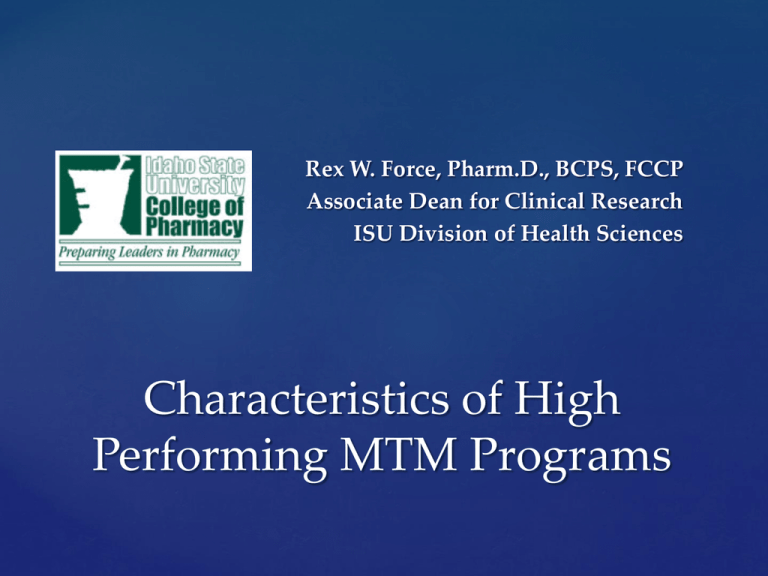
Rex W. Force, Pharm.D., BCPS, FCCP
Associate Dean for Clinical Research
ISU Division of Health Sciences
Characteristics of High
Performing MTM Programs
I have no relevant financial relationships
or commercial interests to disclose in
conjunction with this presentation
Disclosure
Describe the components of medication
therapy management (MTM) programs
Discuss the needs of MTM programs and
outcomes that have been documented for
MTM delivery
Outline processes necessary for establishing
MTM services
Identify performance metrics and quality
outcomes for MTM programs
Objectives
Which of the following is a goal of
MTM?
A. Improve med adherence
and reduce adverse
events
B. Improve pharmacist
reimbursement
C. Increase Part D plan
ratings on the CMS
website
D. All of the above are
goals of MTM
MTM is a patient-centric and comprehensive
approach to improve medication use, reduce
the risk of adverse events, and improve
medication adherence.
Therefore, the programs include high-touch
interventions to engage the beneficiary and
their prescribers.
Required of Medicare Part D providers
Is an opt-out program for beneficiaries
What is MTM?
Is designed to ensure that covered Part D drugs
prescribed to targeted beneficiaries are appropriately
used to optimize therapeutic outcomes through
improved medication use;
Is designed to reduce the risk of adverse events,
including adverse drug interactions;
May be furnished by a pharmacist or other qualified
provider
What is MTM?
N Engl J Med. 2003;348:2635-45.
Why is MTM needed?
At minimum 2 or 3 chronic conditions
May target disease states, but if they do must include
at least 5 of the following:
Alzheimer’s Disease;
Chronic Heart Failure (CHF);
Diabetes;
Dyslipidemia;
End-Stage Renal Disease (ESRD);
Hypertension;
Respiratory Disease (such as Asthma, COPD);
Bone Disease-Arthritis (such as Osteoporosis,
Osteoarthritis, or Rheumatoid Arthritis);
Mental Health (such as Depression, Schizophrenia,
Bipolar Disorder, etc.).
Maximum threshold of 8 chronic medications
Likely to incur drug costs of $3,017 in 2014
MTM Inclusion
Medication therapy review might
consist of:
A.
B.
C.
D.
E.
Gathering medication
history
Assessing cultural or
social issues that affect
med use
Developing a plan for
resolving drug-related
problems
Educating the patient on
appropriate med use and
monitoring
All of the above
Interventions for both beneficiaries and prescribers.
An annual comprehensive medication review (CMR
The beneficiary's CMR must include an interactive, person-toperson, or telehealth consultation performed by a pharmacist or
other qualified provider; and may result in a recommended
medication action plan.
If a beneficiary is offered the annual CMR and is
unable to accept the offer to participate, the
pharmacist or other qualified provider may perform
the CMR with the beneficiary's prescriber, caregiver,
or other authorized individual.
Quarterly targeted medication reviews (TMRs) with
follow-up interventions when necessary.
MTM Services
Medication therapy review (MTR)
Personal medication record (PMR)
Medication-related action plan
(MAP)
Intervention and/or referral
Documentation and follow-up
MTM Service Model
Sometimes called CMR, Comprehensive Med
Review
Collection of patient-specific data
Assessing therapy to identify drug-related
problems
Prioritization
Plan for resolution
Medication Therapy Review
Comprehensive record of patient’s:
Medications – dose, indication, instructions,
start/stop dates, prescriber, etc.
OTCs
Herbals
Vitamins, minerals, and others
Should include provider info, allergies,
pharmacy, patient info, etc.
Should help engage med self-management
Carry with patient at all times
Date last updated
Personal Medication Record
Patient-centered document with list of actions
related to self-management
Goal is to engage patient and encourage
participation in therapy:
Checking med use and adherence, blood
sugars, weights, blood pressure, dietary logs,
functional status, etc.
Medication-related Action Plan
Address identified drug-related problems
Intervention and/or Referral
Collaborate with other members of the
health care team
Documentation
Enhance continuity
Needed for billing
Protect against liability
Assists with documenting outcomes
Billing
Next Steps
JAPhA 2008;48:341-53
Establishing MTM
http://pharmacist.com/implementing-mtm-your-practice
Billing
NPI numbers
CPT codes
Requirements
Business development tools
Business model
Measuring success
Marketing and promotion
Establishing MTM
Some companies act as go-between for
pharmacists and Part D providers
Outcomes MTM
Mirixa
Contracting directly with Part D providers
Commercial insurance
Self-insured companies
Direct-to-patient marketing
Getting Plugged Into MTM
http://pharmacist.com/getting-your-mtm-business-started
MTM program from 2001-2
6 clinics in Minnesota with MTM and 9
clinics without
Measured: resolution of drug therapy
problems, attainment of HEDIS
measures for hypertension and
dyslipidemia
Outcomes of MTM
JAPhA 2008;48(2);203-211.
637 drug-related problems in 285 patients
addressed (2.2/patient)
33.9% needed add’l drug therapy
19.9% needed increased drug dose
14.1% had adverse effect
9.6% non-adherent with regimen
HEDIS measures for:
BP improved, 71% v. 59% (p=0.03)
Lipids improved, 52% v. 30% (P=0.001)
31% reduction in total health care costs for
MTM patients
ROI $12.15 per $1 spent on MTM
Outcomes of MTM
JAPhA 2008;48(2);203-211.
Patient satisfaction with telephonic
MTM
5-point Likert scale (5=strongly agree)
60 subjects received MTM and then
surveys
80% survey response
Overall mean satisfaction score was
4.0 (+/-0.6)
Happy with ability to contact
pharmacist, get questions answered,
content with MTM over the phone
(mean=4.3)
Less happy with referral for
preventive services and other health
care providers (mean=3.6)
Outcomes of MTM
Res Soc Admin Phar 2010;6:143-54
Impact of MTM on mortality, hospitalization,
ED use, daily Rx costs
Matched cohort study
Received MTM between 2006-10
34,532 with MTM matched to 138,128 without
Controlled for several variables
Significant 14% reduction in mortality in
MTM group
3% reduction in hospitalizations although ED
visits increased in the MTM group
No difference in daily medication costs
Outcomes of MTM
AJMC 2014;20(2):e43-e51.
# Rx per day
Generic conversions
Labor costs/Rx
Rx sales
Customer satisfaction
Pharmacy Performance Measures - 2014
Patients adherent to med regimen
Achievement of therapeutic goals
Customer satisfaction – care
directed
Pharmacists will (and should) be
held accountable for contribution
to outcomes
MTM Quality Measurements – 201?
Pharmacy Quality Alliance has created consensus-
driven quality metrics
High risk meds in the elderly (modified Beers’ list)
Appropriate treatment of HTN in persons with
diabetes
Proportion of days covered
ACE/ARB
Statins
Oral diabetes meds
It is expected that CMS will continue to adopt
PQA Measures
CMS Has Adopted PQA Measures
•
•
•
•
{
Resources
From APhA – Core Elements
Pharmacist Services Technical
Advisory Coalition – www.pstac.org
National provider number:
https://nppes.cms.hhs.gov
Pharmacy Quality Alliance:
http://www. Pqaalliance.org
MTM programs represent a significant tool to
improve health
The ROI is positive and other health benefits
have been documented
Part D plans are evaluated on quality metrics
that may be influenced by MTM –
pharmacists will also likely be held
accountable – Medicare is paying the bill!
Pharmacists can embrace the opportunity to
make a difference with MTM
Summary
Companies like Mirixa and
Outcomes MTM:
A. Provide MTM services
directly to patients
B. Act as Part D providers
C. Act as middle men to
distribute MTM patients
to pharmacists for Part
D providers
D. Offer NPI numbers to
pharmacists
Which of the following is true?
A. Patients have not been
shown to be satisfied
with telephonic MTM
services
B. The ROI associated with
MTM services is
insignificant
C. A large study
demonstrated a survival
benefit with MTM
services
D. None of the above are
true
Quality measures related to MTM and
Part D drug programs deal with:
A. Adherence to
regimens
B. Proper evidencebased
pharmacotherapy
C. Safe medication use
D. All of the above



